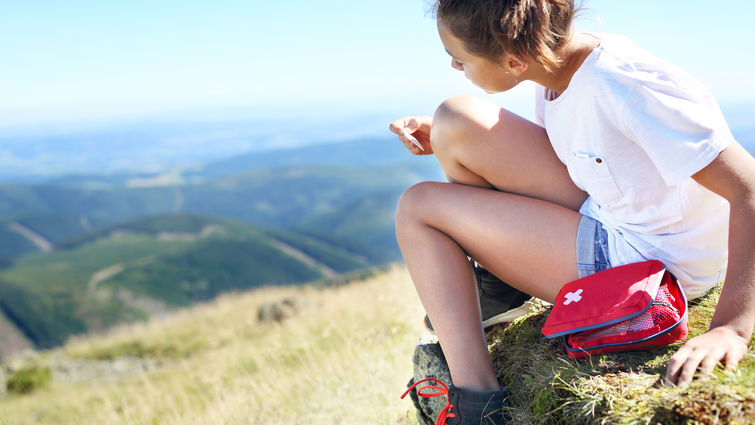
Whether it’s an afternoon spent at the park, a day trip to the beach, or a weekend camping trip—summertime offers families all sorts of fun activities. As you embark on your summer fun, Evelyn Massey, MD and Paul Giem, MD, Life Support Education instructors at Loma Linda University School of Allied Health Professions, offer these safety tips to be prepared for summer time first-aid situations.
1. Have a first-aid kit on hand. It can be a cut on the knee after a bike fall, a painful burn while cooking or broken ankle while hiking — no matter the unexpected situation, a well-rounded and stocked first-aid kit is essential for responding effectively to these common injuries. A rule of thumb is to keep one kit at home and another kit in your car. Ready built first-aid kits are available at most drugstores for purchase and include items such as aspirin, anti-biotic ointment, antiseptic wipes, adhesive tape, band-aids (of different sizes), cotton balls, a first-aid manual, eyewash solution, gauze, gloves, a thermometer and scissors. According to Massey, your kit should fit your family’s needs and should be tailored to include medications for known allergies and medical conditions.
2. Too much heat. Summertime activities can mean long hours in extreme heat and sun. People may be more prone to experience sunburns and heat-related emergencies such as dehydration, heat cramps, heat exhaustion and heat stroke. Symptoms can vary, but common signs of a heat-related injury include confusion, cramps or muscle tightening, dizziness, feelings of faint or fatigued, nausea and headaches. Heat-related conditions can escalate quickly if not recognized and treated. If you suspect someone is experiencing these symptoms, move them to a cool area, provide them with water spray or a damp cloth and if they can, have them drink an electrolytes replacement beverage. If the symptoms persist, call 911.
“The best step you can take for first aid with heat emergencies is by preventing them in the first place,” Massey says. “If you’re outside, drink plenty of water, wear a hat and apply sunscreen. When possible, try to avoid activities during peak heat hours.”
3. Poisonous snakes and spiders. It’s not uncommon for Southern Californians to encounter a snake or spider. While not all are poisonous, assume they are if you can’t identify them. Look for these signs and take safety measures.
- For spider bites, if you experience severe pain at the site of the bite, muscle cramps, headache, fever, vomiting, or breathing problems, call 911. Then wash the bite area with water and soap. Once clean, apply a bag of ice and water wrapped in a towel on the bite until medical help arrives.
- For snake bites, if you experience nausea, vomiting, sweating, weakness, and pain and swelling around the bite area, call 911. Make sure the area is safe, back away slowly or go around the snake if still near. When able, wash the bite area carefully with running water and soap. Keep the person who has been bitten calm and avoid moving the bite area, until medical help arrives.
4. Appling hands-only Cardio-Pulmonary Resuscitation (CPR). You never know on your next adventure when someone can go into cardiac arrest. According to the American Heart Association, approximately 475,000 Americans die from a cardiac arrest each year. The ability to provide immediate assistance can be the difference for a person’s chances of survival, Giem says.
According to the American Heart Association, before administering CPR, assess the situation to ensure that the individual needs it. If they are unresponsive and are having difficulty breathing or gasping, they need CPR. First call 911, then make sure the individual is lying flat on their back. Place the heel of your hand on the center of their chest and your other hand on top. Push down at least 2 inches and push at the rate 100 to 120 compressions. If you know the Bee Gee’s song “Stayin ‘Alive” — push to it, the song is 100 beats per minute.
Giem says, accidents requiring first aid can happen to anyone at any time, so being prepared to help is within your control. “We may not always have control over the results from our efforts, but we do have control over what we do. It’s worth every effort to give someone their best chance by being able to help in emergent situations.”
Want to learn how to perform life-saving steps during an emergency? Check out the Life Support Education courses offered through Loma Linda University School of Allied Health Professions. For more information, contact [email protected] or call 909-558-4977.
